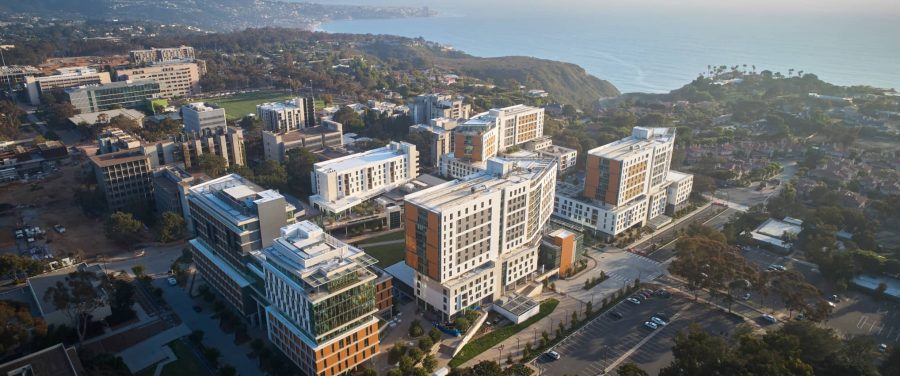The mainstream consensus is that UCSD is socially dead, especially compared to other schools nearby and in the UC system. Some students find that this stigma is starting to change.
UC San Diego’s haunting nickname, “UC Socially Dead,” looms over incoming and current students, popping up within seconds of a simple Google search about social life at UCSD. Though every myth is based in truth, this stigma is more complex than simple fact.
With an expansive ocean on one side and fancy La Jolla neighborhoods on the other, UCSD’s space differs from other UC campuses.
Unlike UC Berkeley or UCLA, campus isn’t enclosed by the hustle and bustle of city life, nor in close proximity to another college campus. Rather than appearing lively and upbeat, La Jolla exudes a more relaxed atmosphere, catering to those who seek out a calm lifestyle.
Fourth-year Manu Agni, associate student president and urban studies and planning major, spoke on another aspect of the city.
“There’s no college town,” he said, emphasizing the dominance of UCSD’s older, richer La Jolla neighbors. “La Jolla is super privileged, very white, very old. That does create this environment where the residents of La Jolla are the first priority for the businesses, for the people here, so there are a lot of expensive restaurants and businesses catered toward wealthy white people.”
This unique environment can translate into the view of UCSD as less “alive” than other campuses. Some students may feel separate from the La Jolla and San Diego residential communities.
New resources provide UCSD students easier access to the greater social sphere of San Diego, with trolleys and buses taking students to La Jolla Village or Square, downtown San Diego, or the nearby mall.
In addition, many local restaurants do take advantage of and cater to the large student population at UCSD, providing student discounts or accepting forms of UCSD Dining Dollars.
Patricia Mahaffey, assistant vice chancellor of student life at UCSD, identified more ways to reach the resources available around UCSD.
“[The new UC San Diego Blue Line trolley system] offers many opportunities to discover the rich culture and activities available across San Diego County,” Mahaffey said. “UC San Diego is experiencing a transformation. It is unprecedented what the campus has undertaken these last several years and it’s really exciting.”
Another potential explanation for the stigma is the inevitable comparison between UCSD and its San Diego counterpart, San Diego State University (SDSU). Niche, an online student resource that provides information and rankings on universities, ranks SDSU as the #3 top “party school” in the US.
In contrast, UCSD is ranked #23 on the same scale, while earning an “A+” in academics and value. UCSD’s prestige and STEM-heavy nature may push students toward a more academic-focused lifestyle.
“Because we have such a heavy party school right across town, I think that we look very dead in comparison,” Agni said.
Students often characterize a lively social life according to the involvement and extent of its school spirit, something often defined by sports teams.
Sports, namely football, play a large role at all of the schools listed in Business Insider’s top 20 US colleges with the most school spirit. UCSD doesn’t have a football team, so students may not feel the same sense of pride for their school teams as they would elsewhere.
But even without a football team, UCSD has plenty of other sports that students can participate in or support, both on Division I competitive and intramural/casual levels.
“Athletics play a large role in contributing to campus spirit and unity,” said Mahaffey. “[Sports games] help build that social life and give students something to do on campus.”
Though UCSD has nearly 50 fraternities and sororities, UCSD’s campus isn’t home to a nearby “frat row,” an area or street concentrated with fraternities and sororities. As a result, students cannot take part in the same “party culture” so often associated with a lively college social life.
“If we had a general place where most of the sorority and frat houses were, maybe it would amp up the socialness,” said senior Resident Advisor Emily Karapetian. Students can’t simply walk around campus on the weekends to find a party, they must seek out houses off campus and make the trek to a new location.
Though some students wish UCSD Greek life was more prominent on campus, Agni actually sees the value in the minimal role of Greek Life at UCSD.
“You’re creating an in-group of students who are ‘in,’ they’re hip, they’re cool, and then you’ve created a big outgroup, students don’t feel like they’re included, and I don’t think that’s a good thing…. Greek life [also] has a lot of problems with sexual violence,” Agni said.
Outside of Greek life, UCSD students host a variety of other kinds of parties and events, including frequent bonfires at Black’s beach or La Jolla shores, college-specific events, fairs, and other celebrations.
Through UCSD’s Center for Student Involvement, students can find even more social opportunities. Organizations can revolve around countless aspects of student life, including political, social, academic, and cultural spheres.
Despite UCSD’s expansive grounds and efforts to expand, the campus actually only houses 39% of its students. This classifies UCSD as a commuter-heavy institution, with the majority of students residing off campus after their first or second year.
With the high cost of living in La Jolla and San Diego, students may struggle to find affordable, yet close housing options.
Agni wishes that more students could have the on-campus living experience.
“Housing growth has not kept up with enrollment growth, and that has pushed a lot of students to live off campus and live far from campus,” Agni said. “It can be pretty hard to be connected to the community from so far away.”
Agni explained that to some extent, the state of California is responsible for the fast-growing student population without housing to keep up.
“[California] also needs to be more responsible, and give UCs the time and money to build the housing before they admit more students. And right now it’s kind of been the opposite- they’re admitting more students and then building the housing later. It needs to change,” Agni said.
Alongside their efforts to accommodate off-campus students, UCSD is still building. New dorms and academic buildings are popping up all around campus. Chancellor Khosla explained UCSD’s goals in a 2017 statement:
“…Our visionary efforts to add more than 10,000 beds on campus will make UC San Diego one of the top primarily residential campuses in the University of California system, and will enable us to provide a four-year housing guarantee for undergraduates and Ph.D. students,” Khosla said.
UCSD is known for its college system, wherein students are divided into smaller communities based on graduation/course requirements and location on campus.
Dorms and individual college campuses are designed to promote engagement between students within their colleges, with central spaces, larger dorms, and dining halls within each campus.
Agni recognized more benefits of the system.
“You have shared identity, you live together, you have similar dining experiences, similar classes that you take,” Agni said.
Students’ experiences as part of their individual colleges differ based on the demands of their academic program, jobs, family, mental health, and living situation. Some students feel isolated to those in their enclosed college community.
“[The system] kind of limits you to the people in your college, I’m not gonna care to branch out and meet other people,” Karapetian said.
Karapetian lived in Seventh College as a freshman, which at the time housed the “overflow” of students from other colleges. This separation from her college was hard at first.
She felt disconnected from the community she was supposed to be getting to know and love. In efforts to improve her connection to Eleanor Roosevelt College, she joined the ERC Student Council, and is now the president.
In addition, Karapetian has made friends in ERC’s five quarter writing sequence.
“When you have a tough writing sequence, it builds community,” Karapetian said.
Agni has also found connections within his college. “A lot of the friends I’ve made are also Marshall students, and I do feel more connected to them and have a stronger sense of community with them,” Agni said.
Incoming students’ preconceived notions about their potential colleges are bound to affect their decisions. When considering what they want their college experience to look like, students may take into account UCSD’s “socially dead” reputation.
“If people come to San Diego and want to go to a party school, they’re gonna go to SDSU,” Agni said.
A molecular cell biology major herself, Karapetian noted that UCSD is a very STEM heavy school, so its applicants may lean towards a focused and academic lifestyle. As a result, UCSD students may not be the ones who prioritize their social lives, or who really care to go out every weekend or party all the time.
Agni doesn’t believe that UCSD students are inherently anti-social, but he also recognizes the reality of students’ priorities.
“UCSD attracts a lot of students who are super hard working and super academically driven,” Agni said. “Maybe some people might not find the mental energy to even try to put themselves out there and be social.”
As UCSD leaves the pandemic behind and begins to re-enter the social world, UCSD students are changing. Mahaffey exemplifies UCSD’s desire for its students to be happy, both socially and academically.
“The students that get engaged on campus do better academically, make more friends and are more satisfied with their college experience,” Mahaffey said.
Mahaffey also recognized that at any university, students have to take action in their social lives.
“While we provide many ways to get involved, there is a certain level of personal initiative that
students must have as well,” Mahaffey said.
Karapetian was met with the same reality. She knew that she needed to try in order to succeed in her social life.
“It really just took me putting myself out there,” Karapetian said. “I went to the biology student orientation where I randomly talked to the girl next to me who was in the same [ERC writing class] as me, and we’ve been friends ever since.”
UCSD may seem socially dead from outside perceptions or Reddit threads, but to some students, this kind of label obscures more than it reveals about their lives as Tritons.
Image courtesy of HKS Society.
















Sam Lowry • May 28, 2022 at 6:20 am
I agree with you that this is a great place for students. After all, it’s not always easy for students to focus on their studies. When I was a student I had difficulties with transferring. And translate.com/services/document-translation was often the only way I could get quality translations. And the most important thing is that you don’t have to go anywhere and you can do everything online.
Adam • May 26, 2022 at 4:20 am
This is a great place to study in my opinion, if you put aside the pursuit of popular colleges. There you can get an excellent education and articles as an engineering consultant in the future. In the article https://engre.co/blogs/articles/what-is-an-engineering-consultant/ I thought this could be a great career decision
Scott M. Mattoon • May 22, 2022 at 6:44 am
I agree that UCSD is a very quiet place. In my opinion, is a pretty prosperous place for students who want a quieter place. I love writing essays. This place excites me as much as this https://samploon.com/free-essays/industrial-revolution/ service because it saves me a lot of time. The last essay I wrote about was Industrial Revolution. This place, along with the service that gives ideas for essay writing, makes me feel like a real writer.